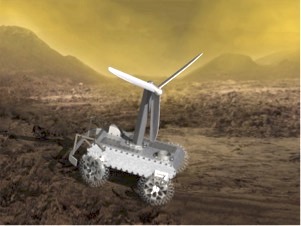
Goddard Space Flight Center, Greenbelt, Maryland 20771
ENGINEERING COLLOQUIUM
Monday, December 6, 2021 / Lecture starts at 3:30 PM On line

Jonathan Sauder
"Hybrid Automaton Rover – Venus"

ABSTRACT -- With its sulfuric acid clouds, temperatures over 450 degrees C, and 92 times the surface pressure of Earth, Venus is one of the most hostile planetary environments in the solar system. Only a handful of Soviet Venera and Vega landers and a Pioneer probe have successfully reached the surface. Even the most robust of these landers survived for only 127 minutes before the electronics failed in the hostile environment. A potential solution to comes from a 16th century technology. The automaton is "a mechanical device capable of performing a series of complex actions to achieve a specific result", or a "mechanical robot". The Hybrid Automaton Rover – Venus (HAR-V), is a mission concept which would replace vulnerable and complex electronic systems with a robust, mechanical approach. By utilizing high temperature alloys and a new concept of operations, the rover could survive for months, allowing it to collect and return valuable long-term science data from the surface of Venus. This science data would be critical for informing and improving models of dynamic planetary systems. The HAR-V mission concept was funded by a Phase I and Phase II NIAC, and culminated in a demonstration of a representative rover in a Venus chamber. This talk will discuss the evolution of the HAR-V architecture, and how the team went about reinventing the rover for the extreme Venus environment.
SPEAKER -- Dr. Jonathan Sauder is the Deputy Manager, Office of Technology Infusion at the Jet Propulsion Laboratory. Prior to this, he was a mechatronics engineer and charter member in the Technology Infusion Group, which seeks to bridge the Technology Readiness Level (TRL) "Valley of Death" for innovative, promising technology concepts. Jonathan’s research focuses on developing unique and innovative mechanical systems, many of which are related to deployable antennas and sunshades, by taking concepts from ideation to verification by testing. He has been the Principle Investigator on a number of projects, including a Phase I and Phase II NIAC study "Automaton Rover for Extreme Environments" and was the Mechanical and Antenna Deployment Lead on the RainCube Spacecraft, the first radar in a CubeSat. He has received a number of best papers and awards, including a Presidential Early Career Award for Scientists and Engineers (PECASE) for demonstrating innovative mechanical technologies to enable a new class of space missions.
Colloquium Committee Sponsor: Brent Warner, NASA-GSFC, 301/286-8568
Engineering Colloquium home page: https://ecolloq.gsfc.nasa.gov